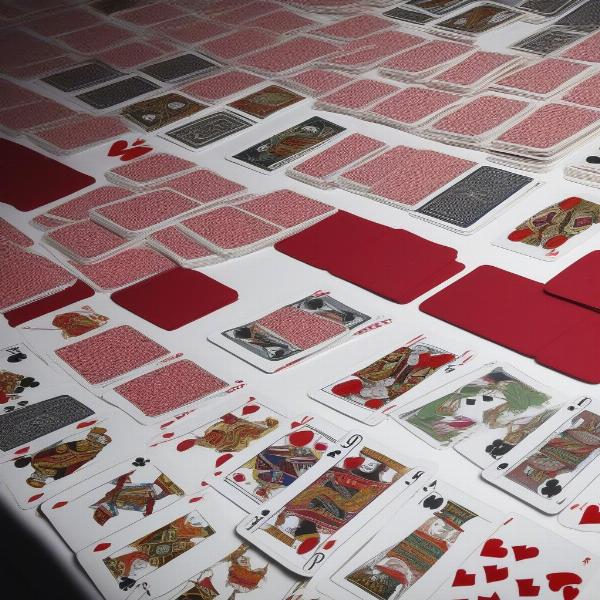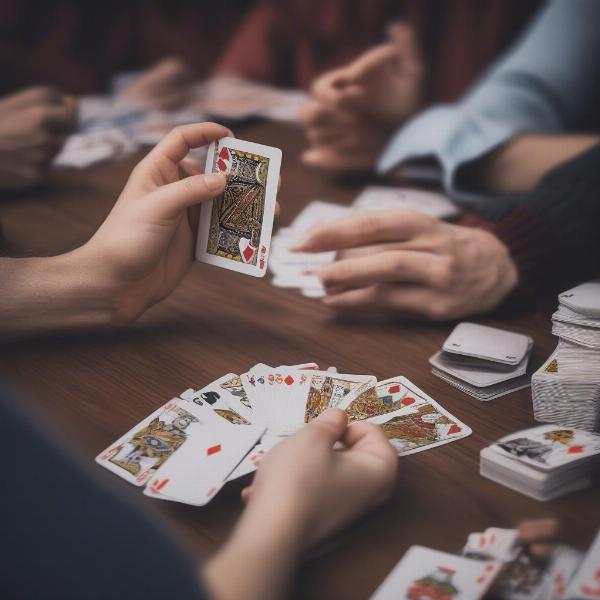Card game war, often a child’s first introduction to the world of card games, is deceptively simple. Yet, behind the basic premise of comparing card values lies a strategy that can intrigue players of all ages. This article, brought to you by supremeduelist.blog, will delve into the specifics of card game war, exploring how to play, its variations, and even some interesting strategic elements.
At its core, war is a game of chance, but understanding the mechanics and different rule variations can significantly impact your enjoyment. We at supremeduelist.blog aim to provide a comprehensive guide that will take you from a novice to a confident war player, discussing everything from the basic rules to the subtle nuances that some may overlook. Let’s get started!
The Basic Rules of Card Game War
The classic game of war, often called “War” or “Battle,” is a two-player game typically played with a standard 52-card deck. Here’s how to get started.
Setting Up the Game
- Shuffle the Deck: The first step is to thoroughly shuffle a standard 52-card deck. This ensures a random distribution of cards.
- Deal the Cards: Deal all the cards face down, one at a time, to each player until the entire deck is distributed evenly. Neither player looks at their cards. This results in each player having their own stack or pile of face-down cards.
 card game war setup with two stacks face down
card game war setup with two stacks face down
Gameplay
- The Reveal: Both players simultaneously turn over the top card from their respective piles and place it face up in the center.
- Comparing Cards: The players then compare the ranks (numerical value) of their cards. Aces are high, and the standard card ranking is followed (2 being the lowest and King the second highest).
- Winning the Round: The player with the higher-ranking card wins the round and collects both cards, adding them to the bottom of their face-down pile.
Going to War
- Ties Lead to War: If both players turn over cards of the same rank (e.g., two Kings), a “war” is declared.
- Initiating War: Each player places three cards face down from the top of their pile, followed by one card face up.
- War Resolution: The face-up cards from each player are compared as before. The player with the higher face-up card in the war wins all the face-down cards and the face-up cards from both the initial draw, and from the War itself. These cards are all added to the bottom of their stack.
- Consecutive Wars: If the face-up cards in the war are also a tie, the process is repeated, resulting in another war. This can continue for several rounds until one player wins.
Winning the Game
The game continues until one player has won all of the cards in the deck. The player who amasses all 52 cards is the winner.
Variations in Card Game War Rules
While the basic rules are straightforward, many variations exist to spice up the gameplay and these variations can drastically change your experience.
Three-Player War
The three-player version introduces a new dynamic where ties become more frequent, requiring careful management of your pile and strategy. In this version, when a tie occurs, all players will go to war against each other, and the player with the highest card from the war will collect all the cards played.
Capturing
In some rule variations, players can capture all cards played when a series of wars happen and the same player always wins. This can increase the rate at which the game progresses, allowing for the game to end more quickly.
Different Card Values
Some variants also tweak the card values of the game. For example, some house rules might lower the value of the ace to 1, instead of having it be the highest. These variations will certainly affect gameplay.
Card Game War Strategy Tips
While the base version of War is largely reliant on chance, a few minor tactical considerations can be useful, especially in variations of the ruleset.
Card Management
Knowing the number of cards in your pile can assist in understanding your odds. If you have a shorter pile of cards, it might be better to play conservatively and avoid entering into wars, as you will risk running out of cards.
Recognizing Patterns
Observing the sequence of cards played can give a clue on whether to risk entering a war or trying to get a better shot at the next round. This can often help with variants that change the value of certain cards.
“Card games, like war, may seem simple on the surface, but when you delve deeper, you realize the nuances that can make all the difference,” says Dr. Eleanor Vance, a card game historian and enthusiast. “Mastering these small details will give you the edge you need to be a champion.”
 players considering tactics in a card game war
players considering tactics in a card game war
Addressing Common Questions:
Is Card Game War suitable for kids?
Absolutely, its simple rules make it great for kids learning about numbers and comparing values. Also, it is a very easy game to pick up, making it fun for the whole family.
Can you use Jokers in Card Game War?
This depends on the house rules used. Some might use Jokers as the highest card, while others might remove them from the deck. This will often change the tempo of the game, depending on the rules used. If you want a different experience you might enjoy playing a round of i declare war online card game.
How can I make Card Game War more interesting?
Experiment with rule variations and add elements like capturing to keep the gameplay fresh and unpredictable. Adding a thematic element, such as the characters of a star wars the clone wars board game can also enhance the experience.
What happens when both players run out of cards at the same time?
This is usually considered a draw. Another round can be played, if desired, or another game started. If you are looking for other games of chance, you can try a game of star wars episode 1 monopoly game.
What are the odds of going to war frequently?
The odds of going to war depends on the number of players involved, and how high each card is. However, statistically, ties are not common and shouldn’t happen too frequently. You can try to get a different experience with a star wars customizable card game card list.
Is there a way to win more consistently?
There is very little player skill required in card game war and as such, there is no consistent way to win. However, small tactics, as seen above, can give small edges. Ultimately it is a game of chance that is suitable for both adults and children. You might get a similar experience playing star wars monopoly game 1997.
Conclusion:
Understanding the nuances of card game war, from basic rules to variations and strategy tips, can transform a simple game into a more engaging experience. While luck plays a significant role, recognizing patterns and employing small tactics can make your games more interesting. As explored throughout this article, brought to you by supremeduelist.blog, “Card Game War How To Play” is simple but can be made more complex to make it more engaging for all players. Whether you’re playing the classic version or a unique variation, remember that the goal is to have fun and enjoy the process of learning and improving your strategic thinking. Now go out there and show your supreme dueling prowess!
Leave a Reply